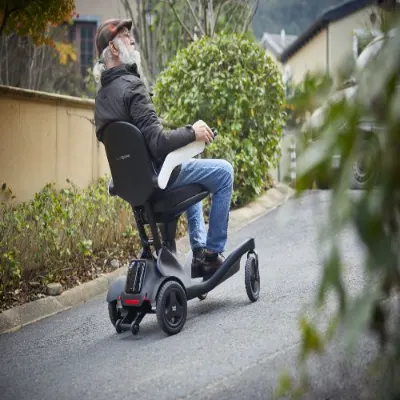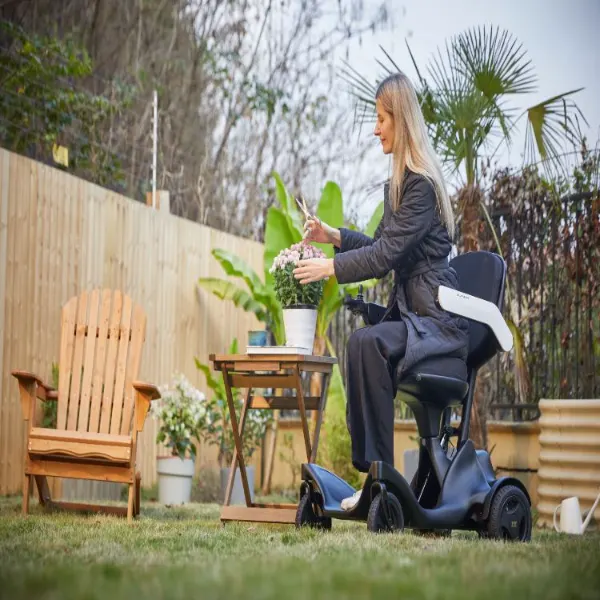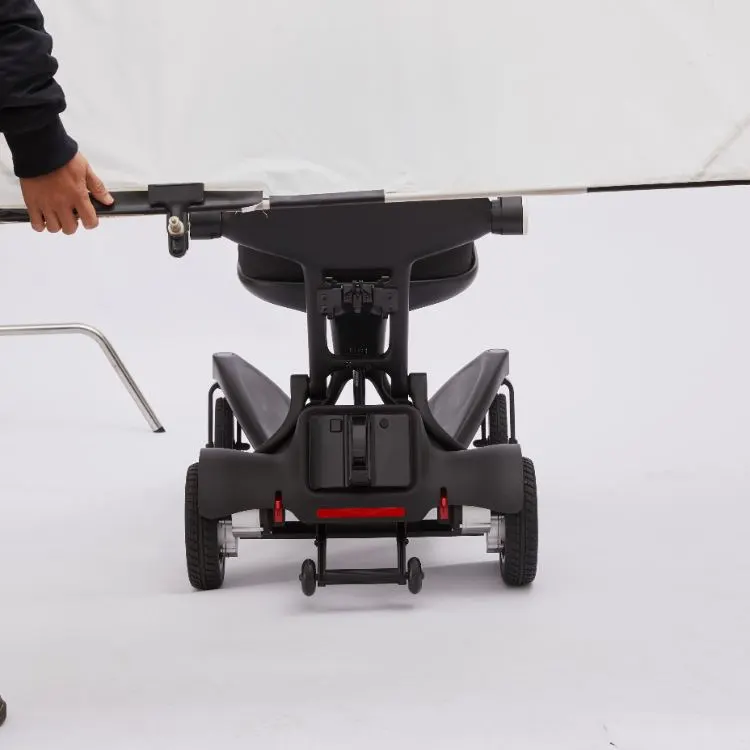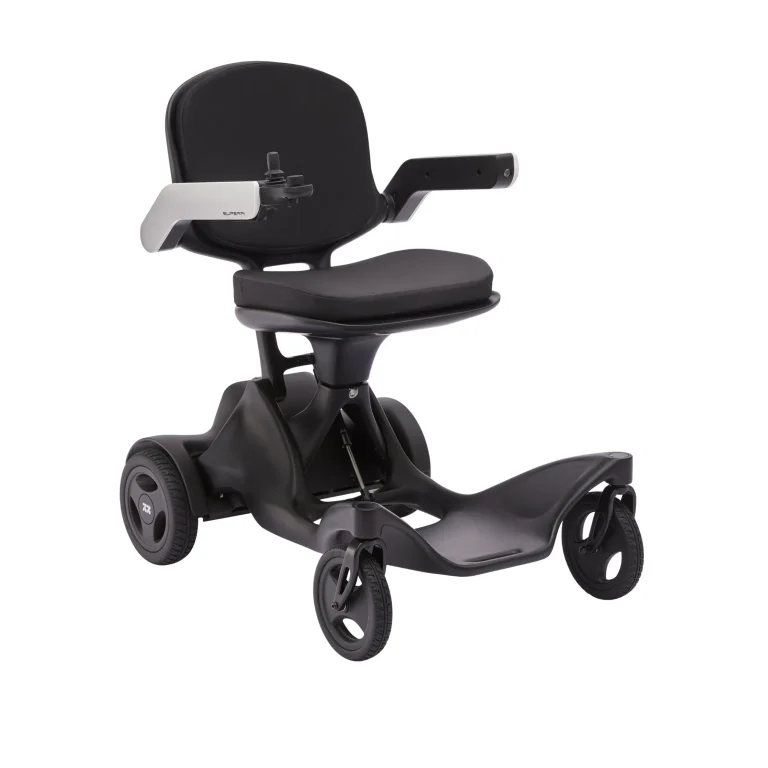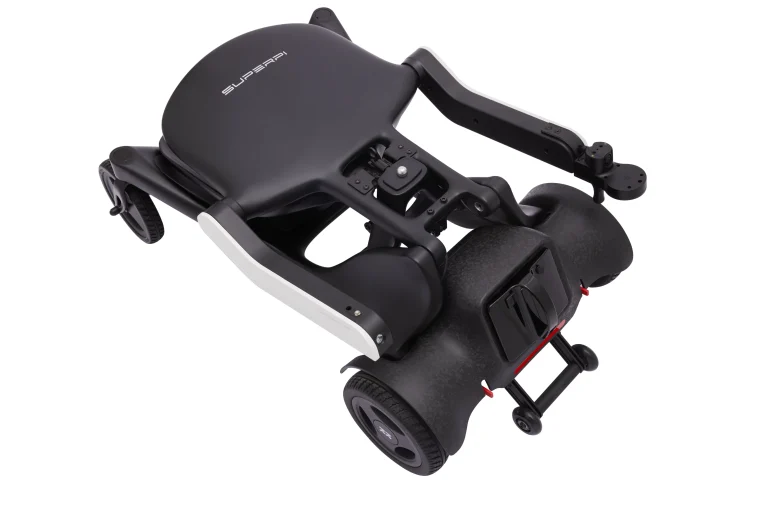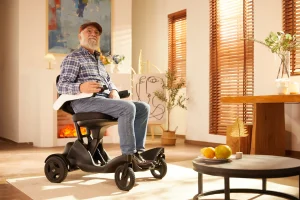
In 2023, a viral dashcam video captured a terrifying moment: a veteran’s power wheelchair suddenly fishtailed on a wet grocery store ramp, sliding sideways into a parked car. The incident went viral not just for its drama—but because it exposed a universal fear. 53% of wheelchair users cite slipping or tipping as their top safety concern (CDC, 2023). Whether navigating icy sidewalks, sandy trails, or rain-slicked ramps, mastering traction and stability isn’t just about mobility—it’s about survival.
This guide merges hardcore physics with real-world hacks. You’ll learn how tire tread patterns affect grip, why your seat angle matters more than you think, and how NASA-inspired stability algorithms can prevent disasters. From DIY traction mods to emergency recovery protocols, we’ll transform your wheelchair from a slip hazard into an all-terrain fortress.
1. The Physics of Disaster: Why Slips & Tips Happen
1.1 The Traction Equation
- Critical Factors:
- Friction Coefficient (μ): Rubber vs. surface (e.g., μ = 0.7 for dry asphalt vs. 0.15 for ice).
- Weight Distribution: 60/40 front/rear ratio optimizes grip.
- Torque Management: Overpowered acceleration breaks tire adhesion.
Formula:
Max Safe Acceleration=�×�×cos(�)−�×sin(�)Max Safe Acceleration=μ×g×cos(θ)−g×sin(θ)
Where �θ = slope angle, �g = 9.81 m/s².
Example: On a 7° wet ramp (μ=0.3), max safe acceleration = 0.3×9.81×cos(7°) − 9.81×sin(7°) ≈ 0.74 m/s² (vs. 1.2 m/s² for dry flat ground).
1.2 The Tipping Point
- Static Stability Factor (SSF):
- SSF = Track Width2×CoG Height2×CoG HeightTrack Width
- Most wheelchairs have SSF 1.0–1.3 (≥1.5 is ideal).
- Dynamic Risks:
- Centrifugal force during turns:��=��2�Fc=rmv2Exceeding this force lifts the inner wheels.
Case Study: A Permobil F3 user tipped at 3 mph on a 15 ft-radius turn due to elevated seat height (CoG increased 20%).
2. Tire Technology: Your First Line of Defense
2.1 Tread Design Matters
- Patterns for Specific Terrain:
- Ribbed Tires: Best for pavement (channel water/debris).
- Lug Treads: Mud/snow (self-cleaning gaps).
- Hybrids (e.g., Schwalbe Marathon): All-terrain versatility.
Traction Test: Use a fish scale to measure pull force—quality tires should require ≥50 lbs to slide on dry concrete.
2.2 Pressure & Compound Tweaks
- Pressure Guidelines:
- Pneumatic Tires: 25–35 psi (lower pressure = larger contact patch).
- Solid Tires: Add silicone-based softeners (e.g., TireJect) to improve grip.
- DIY Winter Traction:
- Screw 1/4” sheet metal screws into treads (14–16 per tire).
- Remove in spring to prevent pavement damage.
Pro Tip: Coat tires with diluted hairspray for temporary ice grip (lasts 2–3 hours).
3. Weight Distribution: Lower, Wider, Safer
3.1 Lowering Your Center of Gravity
- Seat Mods:
- Drop seat height by 2–3” (reduces CoG by 15–20%).
- Install lead weights under the frame (max 10 lbs distributed evenly).
- Battery Placement:
- Rear-mounted batteries improve slope stability but reduce front traction.
Warning: Never stack bags on the backrest—this raises CoG dangerously.
3.2 Expanding Your Wheelprint
- Wheelbase Extenders:
- Bolt-on aluminum plates widening track by 4–6” (check local width laws).
- DIY option: Attach PVC pipes filled with concrete to axle ends.
- Anti-Tip Wheels:
- Install rear outriggers with 6” diameter wheels (prevents >15° tilts).
4. Control Systems: Tech to the Rescue
4.1 Traction Control Algorithms
- How It Works:
- Sensors detect wheel slippage.
- Controller reduces motor power to slipping wheel.
- Redirects torque to grounded wheel.
- Models with Built-In TC:
- Pride Quantum Rehab (Q6 Edge).
- WHILL Model C2 (uses gyroscope data).
Hack: Add a $20 Arduino with accelerometer to older chairs for basic slip detection.
4.2 Dynamic Stability Modes
- Slope Assist:
- Automatically limits speed on inclines >5°.
- Permobil’s iLevel adjusts seat angle mid-slope to lower CoG.
- Descent Control:
- Regenerative braking maintains 1–2 mph on declines (prevents free-fall).
5. Mastering Terrain-Specific Tactics
5.1 Ice & Snow Protocol
- Preparation:
- Apply 70% isopropyl alcohol to tires (lowers water’s freezing point).
- Switch to 4-wheel drive mode if available.
- Driving:
- Move in straight lines; avoid turns >5°.
- Pulse joystick instead of holding (mimics ABS).
- Emergency Exit:
- Throw sand/salt bags (stored under seat) under wheels.
Survival Kit: Foldable crampons ($30), heated grips for joystick.
5.2 Mud & Sand Strategies
- Tire Pressure: Drop to 15 psi (increases contact area by 30%).
- Momentum Management:
- Maintain steady 2–3 mph—too slow sinks, too fast sprays mud into motors.
- Rock chair by alternating forward/reverse if stuck.
Pro Tip: Cover motor vents with nylon stockings (keeps debris out, allows airflow).
5.3 Wet Surfaces
- Avoid Hydroplaning:
- Grooved tires channel water away—replace if tread <1/8” deep.
- Slow to 40% of max speed.
- Anti-Corrosion:
- Spray electrical connections with dielectric grease (prevents short circuits).
6. Emergency Recovery: When You Start to Slide
6.1 Front-Wheel Slip (Understeer)
- Correct:
- Release joystick immediately.
- Turn wheels INTO the slide.
- Gently reapply power once aligned.
6.2 Rear-Wheel Slip (Oversteer)
- Correct:
- Steer AWAY from the slide.
- Shift weight forward (lean torso over knees).
- Feather reverse power to straighten.
Drill: Practice slides in a muddy field with a spotter.
7. Preventative Maintenance
7.1 Weekly Checks
- Tire Inspection:
- Depth gauge: Replace if tread <1/16”.
- Remove embedded nails/glass with pliers.
- Motor Alignment:
- Uneven wear on motor brushes causes torque imbalance.
7.2 Monthly Upgrades
- Upgrade Bearings:
- Ceramic bearings reduce friction by 12% vs. steel.
- Lubricate Pivots:
- Use marine-grade grease on swivel casters.
8. Psychology & Habits: The Human Factor
8.1 Risk Perception Training
- Virtual Reality Simulators:
- Apps like WheelchairSim VR train users to recognize unstable situations.
- Overconfidence Bias:
- 78% of users overestimate their chair’s limits (University of Pittsburgh, 2022).
8.2 Stress Management
- Breathing Technique: 4-7-8 method (inhale 4s, hold 7s, exhale 8s) stabilizes shaky hands.
- Night Navigation:
- Use headlamps with red light mode (preserves night vision).
9. Legal & Insurance Considerations
- Modification Laws:
- Wheelbase extenders may violate ADA width limits (max 36” in public spaces).
- Insurance Claims:
- Document all safety upgrades—insurers may deny “reckless modification” claims.
10. Future Innovations
10.1 Smart Tires
- Pirelli Cyber Tyre Prototype:
- Sensors adjust tread firmness based on surface (soft for sand, rigid for pavement).
10.2 Magnetic Adhesion
- NASA-Inspired Tech:
- Electromagnets engage on steel ramps (tested at MIT, 2024).
Conclusion
Slipping and tipping aren’t inevitable—they’re engineering challenges waiting to be solved. By combining tire science, smart weight distribution, and disciplined driving habits, you can conquer everything from icy parking lots to muddy trails. Remember: every safe journey is a blend of preparation, technology, and respect for physics.
Resources:
- ANSI/RESNA WC-4:2023 Stability Standards: www.resna.org
- Free Traction Calculator Tool: MobilitySafetyLab.com
Call to Action:
Share your worst slip/tip story and how you recovered! Top 3 entries win a free set of all-terrain tires sponsored by GripMaster Mobility.

